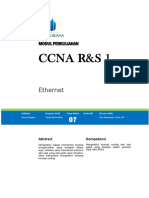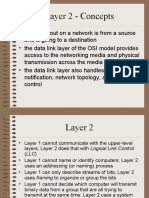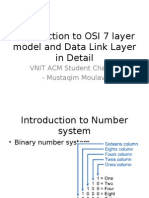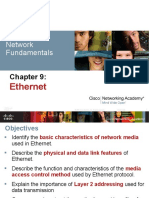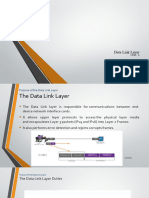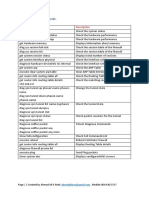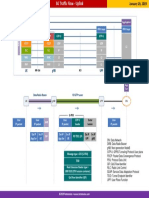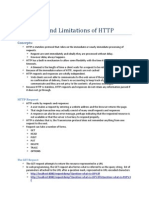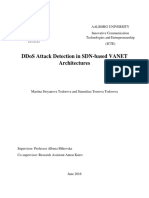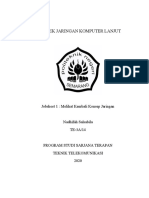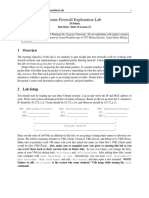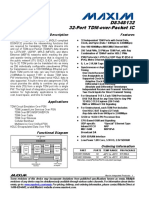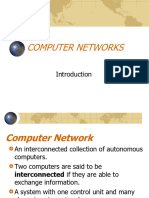MODULE 3: DATA-LINK LAYER
3.1 INTRODUCTION
�INTRODUCTION
• The Data Link layer is responsible
for communications between end-
device network interface cards.
• It allows upper layer protocols to
access the physical layer media
and encapsulates Layer3 packets
(IPv4 and IPv6) into Layer 2
Frames.
• It also performs error detection
and rejects corrupts frames.
�INTRODUCTION
• The Internet is a combination of
networks linked together by
connecting devices (routers or
switches). If a packet is to travel
from a host to another host, it
needs to pass through these
networks.
�FIGURE 3.2 NODES AND LINKS
Access the text alternative for slide images.
5
�TWO SUBLAYERS
The Data Link Layer consists of two sublayers. data link control (DLC) and media
access control (MAC)
• The DLC sublayer communicates between the networking software at the upper
layers and the device hardware at the lower layers.
• The MAC sublayer is responsible for controlling the access to media.
�3.2 DATA LINK CONTROL
�ACCESS TO MEDIA
Packets exchanged between nodes may experience numerous data link layers and
media transitions.
At each hop along the path, a router performs four basic Layer 2 functions:
• Accepts a frame from the network medium.
• De-encapsulates the frame to expose the encapsulated packet.
Re-encapsulates the packet into a new frame.
Forwards the new frame on the medium of the next network segment.
�FRAMING
Data is encapsulated by the data link control with a header and a trailer to form a
frame.
A data link frame has three parts:
• Header
• Data
• Trailer
�FRAME FIELDS
Field Description
Frame Start and Stop Identifies beginning and end of frame
Addressing Indicates source and destination nodes
Type Identifies encapsulated Layer 3 protocol
Control Identifies flow control services
Data Contains the frame payload
Error Detection Used for determine transmission errors
�ETHERNET FRAME FIELDS
• The minimum Ethernet frame size is 64 bytes and the maximum is 1518 bytes. The
preamble field is not included when describing the size of the frame.
• Any frame less than 64 bytes in length is considered a “collision fragment” or “runt
frame” and is automatically discarded. Frames with more than 1500 bytes of data are
considered “jumbo” or “baby giant frames”.
• If the size of a transmitted frame is less than the minimum, or greater than the maximum,
the receiving device drops the frame. Dropped frames are likely to be the result of
collisions.
6
�TWO DLC PROTOCOLS
The logical topology and physical media determine the data control link protocol
used. Two DLC protocols :
• Point-to-Point (PPP)
• High-Level Data Link Control (HDLC)
Each protocol performs media access control for specified logical topologies.
�POINT-TO-POINT (PPP)
One of the most common protocols for point-to-point access is the point-to-point
protocol.
Purpose: A protocol used for point-to-point communication, designed to support
multiple network layer protocols.
Frame structure: Consists of start flag, address, control, data, and frame check
sequence (FCS).
�HIGH-LEVEL DATA LINK CONTROL (HDLC)
It is a protocol for communication over point-to-point and multipoint links.
Purpose: A data link layer protocol for framing and error detection.
Frame structure: Consists of start flag, address, control, data, and frame check
sequence (FCS).
�DIFFERENCE BETWEEN HDLC AND PPP
�3.3 MEDIA ACCESS CONTROL
�MAC SUBLAYER
The MAC sublayer is responsible for data encapsulation and media access control and
provides data link layer addressing.
Data Encapsulation
IEEE 802.3 data encapsulation includes the following:
1. Ethernet frame - This is the internal structure of the Ethernet frame.
2. Ethernet Addressing - The Ethernet frame includes both a source and destination MAC address
to deliver the Ethernet frame from Ethernet NIC to Ethernet NIC on the same LAN.
3. Ethernet Error detection - The Ethernet frame includes a frame check sequence (FCS) trailer
used for error detection.
�3.4 LINK-LAYER ADDRESSING
�LINK-LAYER ADDRESSING
• In an internetwork such as the Internet we cannot make a data reach its destination
using only IP addresses. The source and destination IP addresses define the two ends
but cannot define which links the packet should pass through.
�FIGURE 3.40 IP ADDRESSES AND LINK-LAYER ADDRESSES IN A SMALL INTERNET
Access the text alternative for slide images.
20
�MAC ADDRESS AND HEXADECIMAL
• An Ethernet MAC address consists of a 48-bit binary value, expressed using 12
hexadecimal values.
• Given that 8 bits (one byte) is a common binary grouping, binary 00000000 to
11111111 can be represented in hexadecimal as the range 00 to FF,
• When using hexadecimal, leading zeroes are always displayed to complete the 8-bit
representation. For example the binary value 0000 1010 is represented in
hexadecimal as 0A.
• Hexadecimal numbers are often represented by the value preceded by 0x (e.g.,
0x73) to distinguish between decimal and hexadecimal values.
• Hexadecimal may also be represented by a subscript 16, or the hex number
followed by an H (e.g., 73H).
�MAC ADDRESS AND HEXADECIMAL
• In an Ethernet LAN, every network device is connected to the same, shared media. MAC
addressing provides a method for device identification at the data link layer of the OSI
model.
• An Ethernet MAC address is a 48-bit address expressed using 12 hexadecimal digits.
Because a byte equals 8 bits, we can also say that a MAC address is 6 bytes in length.
• All MAC addresses must be unique to the Ethernet device or Ethernet interface. To ensure
this, all vendors that sell Ethernet devices must register with the IEEE to obtain a unique 6
hexadecimal (i.e., 24-bit or 3-byte) code called the organizationally unique identifier
(OUI).
�MAC ADDRESS AND HEXADECIMAL
An Ethernet MAC address consists of a 6 hexadecimal vendor OUI code
followed by a 6 hexadecimal vendor-assigned value.
�THREE TYPES OF ADDRESSES
• Some link-layer protocols define three types of addresses: unicast, multicast, and
broadcast
• Unicast Address: is the unique address that is used when a frame is sent from a single
transmitting device to a single destination device.
A2:34:45:11:92:F1
�THREE TYPES OF ADDRESSES
• Multicast Address: is received and processed by a group of devices that belong to the same
multicast group.
• A multicast address means one-to-many communication.
• There is a destination MAC address of 01-00-5E when the encapsulated data is an IPv4 multicast
packet and a destination MAC address of 33-33 when the encapsulated data is an IPv6 multicast
packet.
�THREE TYPES OF ADDRESSES
• Broadcast Address: is received and processed by every device on the Ethernet LAN.
• A broadcast address means one-to-all address.
• It has a destination MAC address of FF-FF-FF-FF-FF-FF in hexadecimal (48 ones in binary).
• It is flooded out all Ethernet switch ports except the incoming port. It is not forwarded by a router.
FF:FF:FF:FF:FF:FF
�ADDRESS RESOLUTION PROTOCOL (ARP)
• Any time a node has a packet to send to another node, it has the IP address (network-layer
address of the next node);
• it needs the link-layer address of the next node. This is done by a protocol called ARP located in
the network layer.
• We discuss it when we discuss the network layer.









